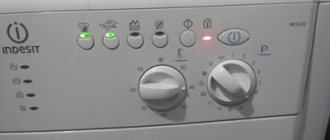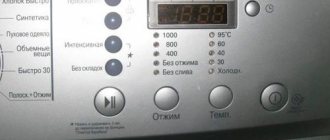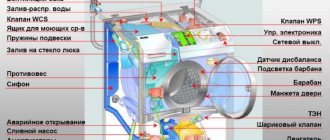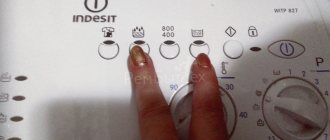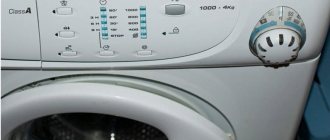What should you do if your washing machine suddenly stops working: call the service center or send the device for recycling? We offer you an alternative solution: step-by-step instructions for diagnosing a washing machine will help not only identify the cause of the breakdown, but also return household appliances to service without involving a repairman.
Causes and symptoms of malfunction
If your lg washing machine does not turn on, you need to understand the reason and find out what went wrong. You should contact the service center as a last resort, and you can fix a minor glitch yourself.
The following signs will indicate a breakdown:
- the start button does not work;
- when connected to the network, the lights on the Indesit device blink;
- if at the start of the program the indicators light up, but the machine does not start washing.
When it became clear that there were problems with the operation of the automatic washing machine, we would try to find out the nature of the damage.
Possible reasons for the failure of the washing machine:
- There is a power problem (the cord or socket is damaged, there is no electricity in the network).
- Burnt wiring or filter.
- Loose contacts in the start button (this causes the lights to blink frequently).
- Broken loading hatch lock.
- The software panel is malfunctioning.
- The wiring or control board burned out (usually during a power outage).
Door problems
Problems with the door in the washing machine
The door may not work in the washing machine if:
- There is a mechanical failure. As a rule, then a characteristic click is not heard;
- Problems in the electronic system. That is, you close the door, hear a click, but the lock does not work.
Causes of mechanical failure:
- Skewed hinges. In this case, the tongue on the door does not fit into the mating groove. You need to check the level, as well as the fastening. If there is a distortion, adjust what you can do without a specialist;
- Tongue distortion. When the tongue does not fit into the lock. Perhaps the rod that holds it in the desired position has fallen out. And then they disassemble the door and put the rod in place or change the hatch handle in the service;
- Guide broken. In some models, the door closes thanks to a plastic guide. Since the plastic can break, the hatch may close without a clicking sound and without locking in the “Closed” position. The solution to the problem is to change the guide in the service.
Causes of electrical failure:
- The locking device is faulty. If the plates of this device are deformed under the influence of current, the interlock no longer functions and must be replaced;
- Foreign body. A foreign object (coins, debris) may get into the locking device and the door will not close. The solution is to remove the foreign body;
- Control module failure. The device does not receive a command from the “brain” to close the door. This happens if the contacts burn out or there is a software failure. The module needs inspection and replacement or repair.
What to do if the washing machine does not turn on
If the Indesit washing machine does not turn on, then to check the equipment you need to use the following algorithm:
- First, you need to make sure that the device is connected to the network, and whether your apartment is not without power. If everything works, but the machine still does not turn on, then you need to check the functionality of the outlet by plugging in another device.
- Next, check the power cord for damage. Perhaps in some place it is pinched or broken. Breaks and creases should be insulated with tape or the wire should be replaced.
- If during the initial inspection it was not possible to identify the cause of the breakdown, then you will need to continue further diagnostics inside the machine, and perhaps contact a service center to repair the equipment.
After the purchase
It happens that a completely new Ariston washing machine does not work despite the fact that the installation and connection were carried out strictly according to the instructions. In this case, you should not open the case yourself. All equipment purchased in the store is under warranty, which is intended to protect the buyer from defects during factory assembly.
After a power surge
After a power surge, you need to check the fuse. In the washing machine, this function is performed by the surge protector. Its task is to prevent damage to the electronic module and eliminate interference from nearby devices. Therefore, during a power surge, the surge protector will most likely be damaged first. As a result of the breakdown: electricity does not pass to the module.
For diagnosis you need:
- It is necessary to remove the cover from the machine body by first unscrewing the rear screws. We need to find the surge protector located on the side of the machine.
- Now let's perform a visual check of the filter and contacts. If the filter is swollen or the contacts are burnt, they must be replaced.
- If you cannot see the problem with the naked eye, we recommend using a multimeter.
- To replace the surge protector, unscrew the bolt that secures the filter to the machine and disconnect the wiring.
The wiring connects the filter to the start button or to the control module. Voltage surges are very destructive for electrical appliances, so we need to check the wiring that may have burned out. To check, attach the multimeter probe to the start button wires. If the button is turned on, and we see resistance on the multimeter screen, then the button is operational, and if not, then the part will need to be replaced.
Detergents can get into the start button, and then, for correct operation, it must be cleaned.
Important! Voltage instability can cause serious damage to your equipment. To prevent this from happening, it is better to use an electric generator to connect the machine.
After moving
It often happens that when moving with a washing machine, a breakdown occurs, even if the transportation was carried out according to all the rules.
In this case, the solution is most likely in the electronic module of the automatic washing machine: water, which in small quantities remains in the powder tray after washing, can get on the electronic module during transportation of the device due to shaking of the machine. Water on the module leads to fatal consequences instantly, or a short circuit may occur when turned on.
To check the module:
- Disconnect the washing machine from the network.
- Remove the top cover.
- We take out the powder tray.
- Unscrew the screws connecting the control panel to the case and remove it.
- Before disconnecting the wiring, let's take a photo with our phone.
- Remove the board by releasing the plastic clips on the panel.
If during inspection you find no damage, the board must be checked at a service center.
What to do if the washing machine stops working due to the control module
Capacitors on the control module fail most quickly. They are first checked with a multimeter: there is resistance - everything is in order, and if the screen shows “0” and the device makes a characteristic sound, then a short circuit has occurred and the conductors should be replaced. To replace them we will need a soldering iron and filters. The filters must be soldered to the positive electrode on the board to maintain the functionality of the remaining capacitors.
The second problem with modules is resistors. They also need to be checked with a multimeter. The resistance of 1st order resistors is 8 Ohms, and the 2nd order resistors are up to 10 Ohms. In 1 case, the overload can reach 2 A, in 2 – up to 5 A. If the values do not correspond, resoldering is necessary. Next, if there are no problems, we test the remaining components of the block. We measure the negative resistance in the thyristor block.
A network overload can damage the thyristor unit. The filter on the unit may have broken down. Then it is necessary to clean the cathode and solder a new part through the positive contact. Due to malfunction of the condenser in the thyristor unit, the trigger may need to be replaced. You can check the functionality of the trigger using the same multimeter by measuring the voltage at the output contacts. The device readings should not exceed 12 V. The trigger must be replaced by soldering the contacts at the output if the voltage does not correspond to the norm.
Hatch lock and drive
On all washing machines, to avoid leaks, the loading hatches are equipped with locking devices. On top-loading machines, this function is performed by a limit switch. When the sunroof is open, the electric motor cannot be started. The limit switch may be responsible for the water supply.
A malfunction of the blocker makes it impossible to start the wash. The lock is located under the machine panel on top. There is a pin or protrusion on the hatch cover, the task of which is to bring the blocker into working condition as soon as the laundry is loaded and the device is hermetically sealed.
If the machine does not start, you should check:
- Serviceability of the blocker mechanics.
- No visible damage.
- There are signs of sticking on the contacts.
If the machine hatch is tightly closed, but the water supply or the machine start is interrupted, then we can conclude that the limit switch is faulty.
To clarify the causes of the breakdown you will need:
- de-energize the device;
- disconnect the blocker from the machine;
- “ring” the limit switch with a multimeter.
If the blocker is faulty, it must be replaced. There is no other way to resolve the malfunction, as operation of the device may become unsafe.
Door switch latch
The door switch plays the role of a lock on a horizontal-loading machine. The machine can only be started when the door switch latch is actuated, that is, the vehicle hatch is tightly closed.
Most often, the switch is located on the body of the machine, but sometimes this part can be part of the door lock.
If, when you turn on the machine, the startup is incorrect, you need to check the switch contacts with a multimeter. Before checking, the machine should be de-energized and freed from the front panel.
Manual switch and timer
The timer circuit for top-loading machines most often involves a function switch. To activate the switch and start the wash, you need to pull the handle towards you and turn it clockwise to set the desired mode. If you suspect that the mechanism is faulty, you can “ring” it with a multimeter.
The sequence of actions is as follows:
- turn off the power to the car;
- remove the top cover;
- find the contacts on the electrical diagram;
- check the contacts for functionality with a special device.
Modern cars are equipped with a digital mode switch, which is built into the electrical control circuit.
In an apartment, you can check not only a mechanical switch, but also a digital one. The switch is “ringed” by the multimeter when the start button is activated.
Engine faulty
All washing machines are equipped with an electric motor that drives the drum and mixes the clothes during the wash.
Top-loading machines usually have a reversible motor. Its specificity lies in the fact that during the execution of the washing program, the motor rotates the drum in one direction, and when draining, the rotation occurs in the opposite direction.
If, when starting, the motor shaft does not rotate the drum, but the washing machine hums, there is a malfunction in the device.
To understand that a machine breakdown is related to the motor, you need to start the engine after removing the drive belt. If the drive is direct, you need to remove the soft coupling during testing.
If the electric motor can be started without a belt, it means there is a malfunction in the rotation mechanism or in the operation of the pump.
For diagnostics, we reconnect the mechanisms separately. If the motor does not start and is noisy, it must be replaced.
Important! All components of the motor electrical circuit are under high voltage. Therefore, when testing the engine, it is necessary to observe safety precautions.
Particular care should be taken when working with moving parts that come into contact with the engine.
For machines with horizontal loading, problems with engine operation are a common cause of failure. Mainly due to laundry stuck between the drum and the rubber rim.
It’s quite easy to identify such a malfunction: you don’t have to disassemble the machine; a thorough inspection is enough to find clothes caught on the drum.
Switch Shaft Slider
This breakdown is possible on machines with mechanically set washing programs. You should check whether the slider engages the shaft and whether modes switch when rotating the timer handle.
Over time, the slider is erased, making it impossible to switch the program.
To identify or eliminate this breakdown, it is necessary to de-energize the device and remove the top cover to access the internal structure of the timer. Check how tightly the slider and shaft adhere when rotating the handle.
Replacing brushes
To replace the brushes, you must perform the following steps sequentially:
- remove the back of the case;
- unscrew the bolts and release the engine and pulley from the belt;
- remove the fasteners from the engine and pull them towards you;
- Disconnect the wires and remove the engine.
Now you can inspect the brushes. If the brushes are worn out, it's time to replace them. We unscrew the screws that secure the brush, terminals and wires. Then you should perform the steps in reverse order.
Slat repair
If you hear noise when turning the rotor manually, then you need to check the lamellas. When examining the slats, you will most likely find burrs and cracks. This happens when the washing machine is used for a long time. When the brushes come into contact with the lamellas for a long time, the brushes themselves wear out, and characteristic grooves appear on the lamellas. Detachment of the lamellas due to the rotor shorting is also possible.
To repair the lamellas, it is necessary to grind the anchor and clean the space between the lamellas.
If the problem is a burnt winding, then the motor should be replaced. Due to the high cost of the motor, it is not practical to change it. It's easier to buy a new machine.
Shuts down suddenly
What is the reason that the machine turned on, washed and suddenly stopped washing? First you need to understand how the washing machine turns off. And then notice in which wash cycle this happens. If a shutdown occurs during the heating of water or when the engine is working hard, this indicates an overload of the circuit. In this case, you should immediately turn off the device from the network and diagnose the socket and wiring.
Important! To de-energize the apartment, you need to turn the switch on the machine to the “off” position.
In the event of a sudden shutdown, the machine itself can tell you what exactly went wrong by displaying an error code on the display. The self-diagnosis system of the washing machine will help with this. The reason for such a shutdown may be a malfunction in the operation of the control module, if semiconductor elements are poorly soldered on the board or one of the tracks on the board is broken. You should not fix the problem yourself. We recommend contacting a service center.
Error codes
| Ariston | Bosch | Indesit | LG | Samsung | Zanussi | |
| The hatch is not closed, the lock is faulty | F17, DOOR | F01 | F17 | dE | DE, DOOR | E41 |
| Motor problems, short circuit | F01 | E02 | F01 | — | — | E51 |
| Water does not flow into the drum, the water level sensor is not working correctly | F04 | F02 | F04 | I.E. | E1 | E11 |
| Drum balancing is out of order, laundry is overloaded | — | — | — | UE | E4 | E39 |
| Water leak | — | F04 | — | E1 | E9 | E13 |
| Button error | F06 | — | F06 | — | — | — |
When the washing machine does not drain water
If the machine stops draining water, this can become a serious problem. Excess water in the washing machine can not only negatively affect the general condition of the room, but also damage household appliances. The machine will assume that there is already water in the tank and will not add clean liquid. As a result, clothes will be washed in dirty water, and this will not make them cleaner. In addition, water in the machine can cause corrosion of metal components and lead to a short circuit.
The cause of the drainage failure may be:
- The drain pump or the filter in it may be clogged.
- Electronic unit or sensor. In their place, in case of breakdown, it is necessary to install new parts.
In case of water drainage problems, turn off the power to the machine and empty it of any water accumulated in the tank. To do this, you need to remove the bottom panel from the washing machine body; in the right corner there is an emergency drain hose. The hose should be pulled out and the cap unscrewed, thereby freeing the machine from the liquid. After the water has drained, return the hose to its original position and find a screw-on plug nearby - this is the cleaning filter. The filter must be cleaned at least once a month.
When you unscrew the cap, liquid will drain out, no more than a glass in volume. We will have a filter in our hands that needs to be cleared of debris, and an impeller in the hole.
Diagnosing the impeller is quite simple:
- If, when you try to rotate, the impeller does not move, then the problem is in the pump. The pump should be removed and cleaned.
- If it rotates, but with difficulty, then the pump is fine, the problem is something else.
- If the impeller moves jerkily, then diagnostics should be carried out. To do this, remove the top and back panels from the machine body and disconnect the terminals. For the pump to operate, the voltage must be 220 V. Let's put a third-party cord in this place, and if the impeller then starts rotating, then everything is in order.
When diagnosing the impeller, it is necessary to observe safety precautions, since rotation occurs at high speeds.
How to get out of the situation
Repair as a way to troubleshoot a washing machine is an effective method of restoring functionality. However, the service has some disadvantages:
- The lack of a real picture of the symptoms of the car entails the risk of repairing non-existent breakdowns;
- Transportation of equipment for research is not always available, convenient and acceptable for the owner;
- Most craftsmen prefer to carry out repairs at the site of operation, which does not always guarantee the accuracy of diagnosis and the level of quality of work.
If the car doesn't turn on at all
In such cases, the first thing to do is check the power supply from the electrical network. It will be more convenient to do this if the machine is connected to a separate machine. Perhaps he was simply knocked out. If there are other consumers on the same line as the equipment, it is best to check the operation of one of them:
- The first step is to check the presence of voltage in the apartment, as well as whether the machine is connected to an outlet;
- The connection point itself is checked quite simply; for this you can connect some kind of mobile consumer. If the following device does not work, you need to call an electrician on duty;
- If the power problem is temporary and you need to do the laundry today, you can temporarily supply power from another outlet with an extension cord.
Other reasons of a constructive nature include a malfunction of the equipment power button, a breakdown of the control unit, a break in the network wires inside the machine, or a temporary lock. It is quite difficult to understand such issues, even at first glance. This cannot be done without special equipment, skills and professionalism of the master.
The washing machine does not spin
One of the useful functions of the machine is spinning. After all, in the process of alternating rotation of the drum, water is knocked out of the laundry, and we take the clothes out of the machine almost dry. The spin mode means that after rinsing, water stops flowing into the drum, rotation occurs first in one direction, then in the other. Spinning is completed by rotating the drum at high speeds in one direction. If the machine does not spin the laundry, then there is a failure in the nodes involved in the process: programmer, drive or winding switching relay.
When testing you should:
- turn off the machine from the network;
- remove the belt;
- turn off the motor;
- start the engine from the external network through the electrical circuit. Terminals 3 and 4, as well as 5 and 6, are responsible for the modes.
Important! When starting the engine, there may be a jerk and the motor will begin to rotate. We recommend being extremely careful, as its rpm can exceed 10,000.
The drum stopped spinning
The device may show various signs of failure. They signal various malfunctions:
- You can hear motor noise and relay clicks. The machine fills and drains water, but the drum stands still. This occurs when the drive belt breaks. It transmits torque from the motor to the drum.
- The drum can be swung freely by hand, but it is loose. Bearings are worn out. Several cycles before the drum stops spinning completely, the machine will make loud noises and spin poorly.
- The motor noise is not heard, the display shows a tachometer error. This element reduces the speed at which the motor rotates the drum.
The washing machine may stop spinning the drum if the motor breaks down. The brushes that transmit torque may be damaged and worn out.
What to do to make your machine last longer
To avoid all kinds of damage, it is important to use the washing machine carefully.
For proper operation you must:
- Strictly follow the instructions.
- Give the washing machine a rest. It is recommended to take breaks during continuous washing. So, the machine will last longer.
- After unloading clean laundry, the hatch should be left slightly open, which will prevent the appearance of mold and unpleasant odors. It is also necessary from time to time to wipe the cuff, wash the dispenser tray and run the machine in cleaning mode. It is important to prevent scale using special cleaning products.
- In order not to damage the machine, it is recommended to use special washing powders and gels. Therefore, before purchasing cleaning products, you should familiarize yourself with the composition indicated on the bottle.
If you follow all these simple rules, your equipment will last a long time.
Blockages in the system
The conservative method of operating “smart” equipment, which consists in leaving the equipment to self-determination, will not work. Elementarily, the internal channels of the system responsible for washing and draining can become clogged over time. The standard pre-filter is usually located at the bottom of the front of the equipment. It unscrews easily. It usually always contains pieces of fabric and particles of lint, as well as other elements. If you do not clean the coarse filter in a timely manner, over time this may affect the normal operation of the machine, for example, it will stop quickly draining water during the break between the washing and draining, washing and rinsing modes.
The washing machine also has a certain number of fine filters. One is on the inlet solenoid valve, and the second is on the drain valve. Excessive clogging of these parts may cause the washing or draining mode to stop, respectively.
